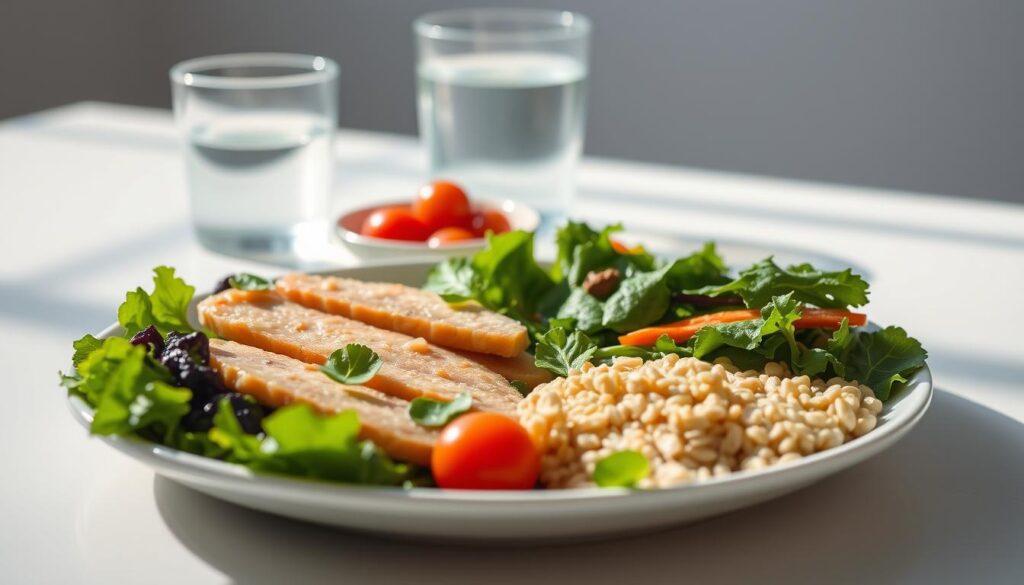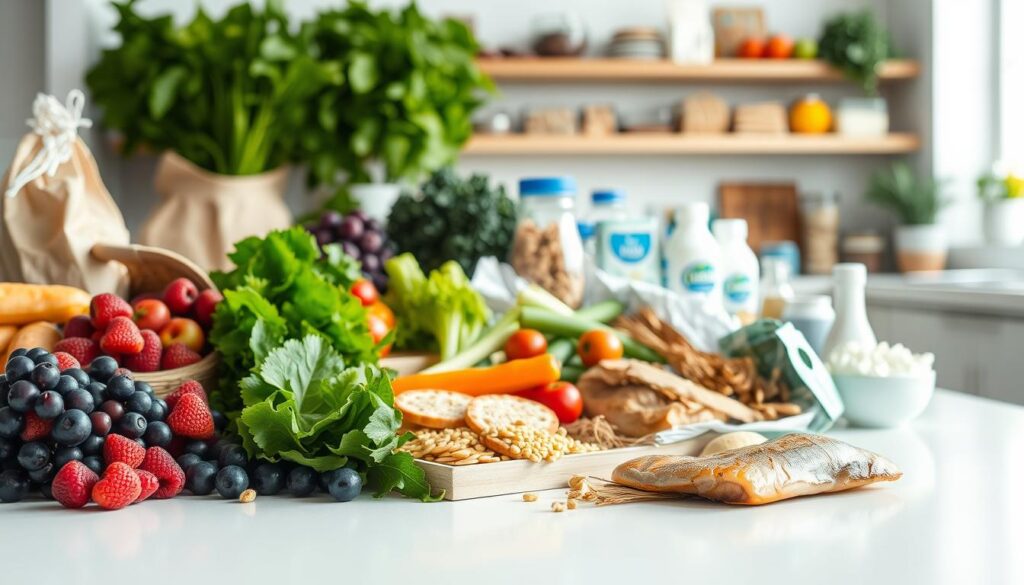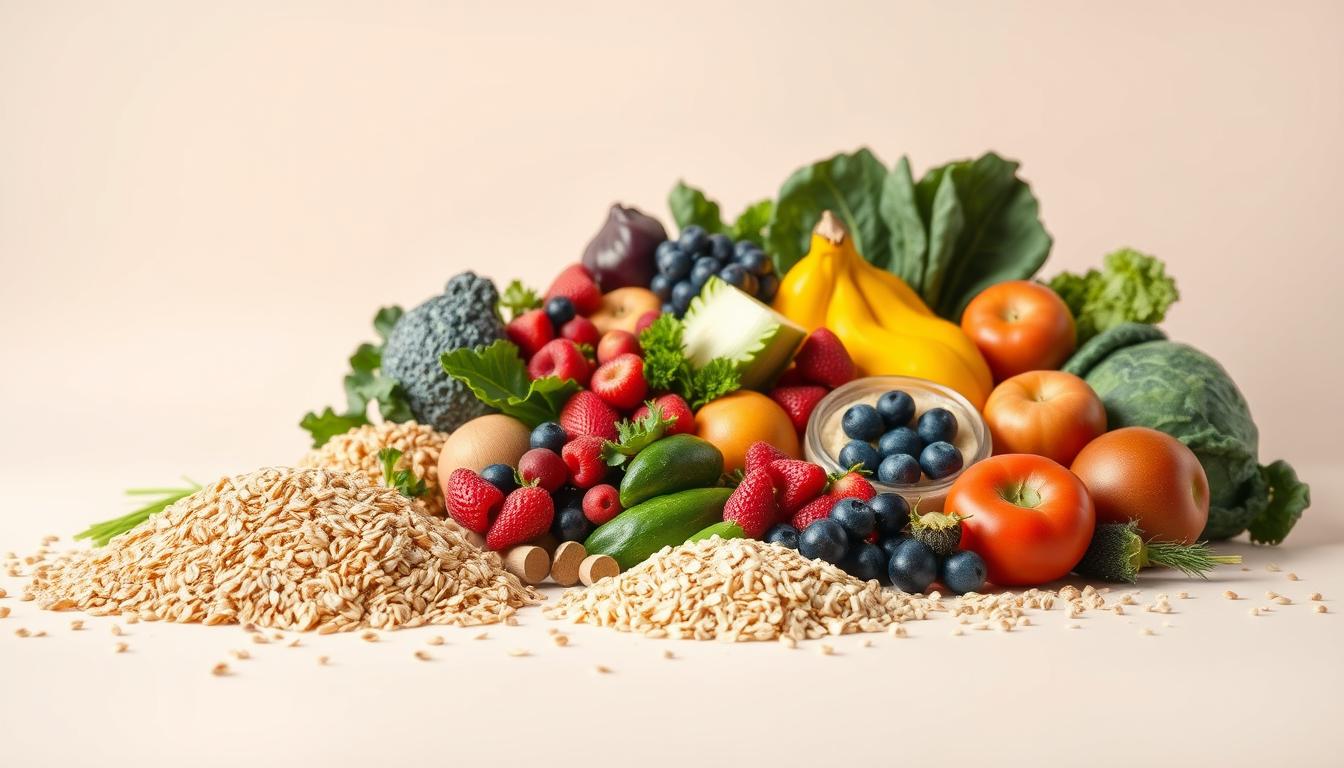Once, I felt stuck, looking at diets that made me hungry or felt too hard. I didn’t need another quick fix. I wanted a way to eat that felt real, lasting, and fit my life. That’s when a smart meal plan for weight control changed everything. This guide is for anyone ready to move from frustration to confidence, making every meal a step towards lasting change.
A balanced meal guide isn’t about cutting out food—it’s about picking foods that fuel your body and meet your goals. Whether you’re a busy parent, a student, or someone who’s tried every trend without success, this roadmap shows how smart eating can make weight loss feel natural. Let’s create a plan that works with your life, not against it.
Key Takeaways
- A meal plan for weight control focuses on quality, not deprivation.
- Proper planning ensures you get nutrients without overcomplicating your routine.
- A balanced meal guide adapts to your lifestyle, making success achievable.
- Sustainable weight loss starts with understanding your body’s needs.
- Small, consistent choices create big, lasting results.
Understanding the Basics of Meal Planning
Meal planning is more than just picking meals for the week. It’s a roadmap for your health. A slimming meal planner turns random eating into a nutrition plan for fat loss that meets your goals. It’s about making balanced choices, staying organized, and avoiding common mistakes.
What is Meal Planning?
Meal planning means planning out meals and snacks before they happen. It looks at what you need, what you like, and what you want to achieve. It’s like a strategy to make life easier and make sure you’re eating right.
Benefits of Meal Planning for Weight Control
- Portion control: Helps you avoid eating too much by portioning food ahead of time.
- Saves money: Reduces spending on impulse buys and food that goes to waste.
- Time efficiency
A nutrition plan for fat loss through meal planning means making consistent choices. This cuts down on guesswork and cravings.
Common Myths Around Meal Planning
| Myth | Reality |
|---|---|
| “It’s time-consuming” | Saves hours weekly by reducing decision fatigue. |
| “Expensive to start” | Batch cooking and using seasonal ingredients can save money. |
| “Eating the same meals every day” | Flexibility exists—swap ingredients while keeping nutritional balance. |
A slimming meal planner fits your lifestyle, proving these myths wrong and helping you make smarter choices.
Essential Nutritional Components
Creating a nutritional strategy for weight reduction begins with understanding the basics. Each nutrient either fuels your body or aids in metabolism. Let’s explore how these elements combine for a lasting plan.
Discover the Secret to Fast Weight Loss!
Macronutrients: Proteins, Fats, and Carbs
Proteins are key for muscle strength while cutting calories. Aim for 0.7–1 gram per pound of body weight each day. Choose foods like grilled chicken, tofu, or Greek yogurt.
Healthy fats, such as almonds or olive oil, slow digestion and prevent hunger. Whole grains and fiber-rich carbs like quinoa or sweet potatoes help avoid blood sugar spikes.
- Proteins: Chicken, fish, beans (4-6 oz per meal)
- Fats: Avocado, chia seeds (20-35% of daily calories)
- Carbs: Oats, brown rice (45-65% of intake)
Micronutrients: Vitamins and Minerals
Vitamins and minerals are crucial for body functions but don’t add calories. Iron in spinach fights fatigue, and magnesium in almonds aids nerve function. Leafy greens and citrus fruits boost vitamin C and K levels.
Supplements like zinc or B12 might be needed on strict diets.
Understanding Caloric Deficit
A deficit means burning more calories than you eat. A 500-calorie daily deficit leads to about 1 lb lost per week. Avoid cutting calories too low, below 1,200 for women or 1,500 for men.
Extreme diets slow metabolism and increase cravings, making success harder. Use apps like MyFitnessPal to track calories and stay within safe ranges.
By combining these elements, you create a plan that nourishes your body without sacrificing nutrition. Focus on whole foods and consistency for lasting results.
Creating a Balanced Meal Plan
Starting a diet plan to lose weight means having a balanced meal guide. This guide makes choosing meals easier. It helps you create meals that are good for your body and help you reach your weight goals.
Portion Control and Serving Sizes
Learning about portions is easy without scales. Use common items as guides:
- A deck of cards = 3-4 oz of protein (chicken, fish)
- A baseball = 1 cup of veggies or grains
- A smartphone = a serving of nuts or cheese
Choosing Whole Foods Over Processed
Whole foods like veggies, fruits, and lean proteins keep you full longer. Choose carrots with hummus over chips. Pick oatmeal with berries instead of sugary cereal. Focus on unprocessed foods to get more nutrients and avoid empty calories.
Sample Balanced Meal Ideas
| Meal | Option 1 | Option 2 |
|---|---|---|
| Breakfast | Scrambled eggs + spinach + 1 slice whole-grain toast | Plain Greek yogurt + chia seeds + mixed berries |
| Lunch | Grilled chicken salad with quinoa, avocado, and balsamic dressing | Grilled veggie wrap (whole-wheat tortilla, black beans, salsa) |
| Dinner | Salmon + roasted Brussels sprouts + sweet potato mash | Vegetarian lentil curry with brown rice and steamed broccoli |
| Snack | Apple slices + almond butter | Hard-boiled egg + baby carrots |
“Whole foods fuel your body without overcomplicating your plate.”
These meal ideas can be changed to fit your taste. Swap proteins or adjust portions to meet your calorie needs. A balanced meal guide keeps your choices flexible while focusing on nutrition and sustainability.
The Role of Meal Timing
Timing is crucial for a meal plan for weight control. It affects how your body burns calories, feels hungry, and has energy. This part explains how setting a meal schedule can help you achieve your goals.
Burn Fat & Boost Your Metabolism!

Importance of Regular Meal Intervals
Eating at regular times keeps your body running smoothly. Skipping meals can lead to overeating later. I suggest eating every 3–5 hours to keep your energy steady. Here’s what to aim for:
- A morning meal within 1 hour of waking
- Small, balanced meals every 3–4 hours
- No fasting longer than 12 hours overnight
Strategies for Incorporatinging Snacks
Snacks help control hunger and keep blood sugar stable. Choose snacks with protein and fiber to avoid energy drops. Here are some good options:
- Apple slices with almond butter
- Hard-boiled eggs and carrot sticks
- Plain Greek yogurt with chia seeds
How Meal Timing Affects Metabolism
Your metabolism likes routine. Eating late can slow digestion, while morning calories might burn faster. Follow these tips:
- Finish meals 3 hours before bedtime
- Focus on protein and fiber at breakfast/lunch
- Reduce carb-heavy meals after 7 PM
Science backs up the idea that timing can be flexible. Find a schedule that fits your life. A meal plan for weight control works best when it’s tailored to you but consistent.
Special Dietary Considerations
A good healthy eating program must fit your unique needs. Whether you’re vegetarian, gluten-free, or on a low-carb diet, these tips help keep your plan balanced and easy to follow.
Meal Plans for Vegetarians and Vegans
Plant-based diets are rich in protein from foods like tofu, tempeh, and lentils. Whole grains such as quinoa are also key to meet amino acid needs. Gardein offers easy meat alternatives for most recipes. Key tip: Make sure to get 0.9 grams of protein per pound of body weight each day.
Gluten-Free Meal Planning
Gluten-free diets need careful attention. Choose grains like rice, buckwheat, and certified oats that are naturally gluten-free. Always use separate cooking tools to avoid cross-contamination. Remember, even some sauces or salad dressings can have hidden gluten.
- Incorporate amaranth or millet for fiber
- Choose gluten-free certified products
Low-Carb and Keto-Friendly Options
Low-carb diets emphasize healthy fats and proteins. Avocados, nuts, and fatty fish like salmon are great choices. For keto, keep net carbs under 50 grams a day. Try zucchini noodles instead of pasta and almond flour for baking.
“The best healthy eating program aligns with your body’s needs, not trends.”
Final Notes
Always talk to a dietitian before big changes. Your healthy eating program should grow with your goals. Focus on whole foods and always check labels to stay on track.
Shopping for Healthy Ingredients
Starting a nutrition plan for fat loss means smart shopping. A good plan ensures every item you buy helps you reach your goals. Here’s how to make your shopping trips better:
How to Create a Grocery List
First, list what you need for the week. Organize by section—like produce, dairy, and pantry. This helps you avoid buying junk. Stay true to your list to keep on track with your nutrition plan for fat loss.

Tips for Buying Seasonal Produce
Buying seasonal fruits and veggies saves money and tastes better. Here’s what to choose by season:
| Season | Best Picks |
|---|---|
| Spring | Asparagus, strawberries |
| Summer | Berries, corn, zucchini |
| Fall | Pumpkins, apples, sweet potatoes |
| Winter | Citrus, Brussels sprouts |
Understanding Food Labels
Reading labels helps avoid hidden sugars and additives. Here’s what to look for:
- Check calories per serving to match your plan.
- Avoid items with added sugars in the top three ingredients.
- Choose whole grains like quinoa or oats.
“Ingredients lists tell the real story—always read them!”
Meal Prep Techniques
Meal prep makes managing weight easier by organizing your kitchen. It doesn’t matter if you’re new to cooking or have years of experience. Learning these tips helps keep your meals healthy and easy to grab.
“Meal prep isn’t about perfection—it’s about consistency.” – Nutritionist Sarah Lee
Benefits of Bulk Cooking
Cooking in bulk saves time and helps avoid unhealthy snacking. Prepare proteins like chicken or tofu once a week. Then, portion them out for quick meals. Use Instant Pots or Crock-Pots to cook faster. This method also reduces grocery trips, helping you stick to your weight management meal prep goals.
Storage Methods for Freshness
Use airtight containers like Pyrex or Rubbermaid to keep food fresh for 3–5 days. Freeze leftovers in labeled bags to keep them longer. Store raw veggies in containers with damp paper towels to keep them crisp. Always follow USDA guidelines to prevent food from spoiling.
Easy Make-Ahead Meals
Make bases like quinoa or brown rice for grain bowls. Cook soups and chili in bulk for easy lunches. Mix and match toppings each week for variety. Try these ideas:
- Vegetable stir-fry kits with pre-cut veggies
- Hard-boiled eggs for quick protein boosts
- Pre-portioned salad kits in mason jars
Change up your recipes monthly to avoid getting bored. Swap ingredients weekly to keep things interesting. With these tips, weight management meal prep becomes a routine, not a hassle.
Staying Motivated through Meal Planning
Staying motivated on a calorie-controlled menu is more than just willpower. Small wins, consistent tracking, and community support build lasting habits. Let’s explore how to keep your momentum going with actionable strategies.
Start by setting realistic goals. Break big targets into weekly actions. For example, add one more vegetable to dinners or cut out soda gradually. Celebrate small wins, like fitting into old clothes or better sleep, to keep going.
Setting Realistic Goals
- Track weekly progress with a journal or app
- Focus on lifestyle changes, not quick fixes
- Adjust goals as your routine adapts
Tracking Progress Beyond the Scale
Use apps to log meals and mood, but don’t obsess. Note how a calorie-controlled menu impacts energy levels or digestion.
“80% of sustained weight loss involves consistent tracking,” says a 2023 dietary study.
Progress isn’t always straight. Fluctuations are normal.
Building Your Support Network
Share your journey with a friend or join online groups like MyFitnessPal communities. Weekly check-ins with a nutritionist or buddy boost accountability. Celebrate successes together to stay focused.
Flexibility is key. Adjust your calorie-controlled menu as life changes—travel, stress, or cravings. Motivation thrives when you honor your needs without guilt. Stay kind to yourself, and let support systems carry you forward.
Adapting Your Plan
Weight loss journeys rarely move in a straight line. Even the most carefully crafted slimming meal planner needs adjustments over time. Knowing when and how to make changes can keep you moving forward without feeling stuck.
Recognizing Signs of Plateau
A plateau isn’t always a setback. Your body adapts to routines, sometimes slowing progress. Track changes for at least two weeks before assuming a stall. Factors like water retention or muscle gain can mimic plateaus.
Ask yourself: Have I been consistent with portions? Am I tracking hidden calories like sauces or dressings?
Adjusting Portions and Choices
- Shrink portion sizes by 10-15% if progress stops
- Swap high-calorie ingredients (e.g., avocado for cheese)
- Try a 24-hour “reset” day with lean proteins and veggies
Refresh Your Recipe Library
Boredom with meals leads to cravings. My slimming meal planner includes a “rotation feature” for new recipes weekly. Try global cuisines like Thai green papaya salads or Japanese tamari-glazed salmon. Variety keeps metabolism active and motivation high.
“Rigid plans fail. Flexibility is the secret to lasting change.” – Nutrition Today Journal, 2023
Adaptation isn’t failure—it’s proof you’re paying attention. Small tweaks, not overhauls, often make the biggest difference. Your meal plan should grow with you, not against you.
Mindful Eating Practices
Creating a healthy eating program is more than just picking the right foods. It’s about how you connect with food. Mindfulness makes eating a mindful act, matching your meals to your body’s needs. Let’s dive into how to develop this mindset.
Understanding Hunger Cues
It’s key to know the difference between real hunger and emotional cravings. Before you eat, ask yourself: “Am I hungry, or am I looking for comfort?” Use a hunger scale from 1–10 to stay balanced.
- Physical hunger: It starts slowly and is satisfied by any food.
- Emotional hunger: It comes on fast and wants specific foods.

Techniques to Avoid Overeating
Eat slowly and chew well. Take breaks between bites. Using smaller plates can make food seem bigger. A 2017 study in Appetite showed this method cuts down food intake by 20%. Here are some tips:
- Stop eating halfway to check if you’re full.
- Don’t eat with distractions—no screens or multitasking.
“Mindful eating reduces mindless snacking by 34%.” — Harvard T.H. Chan School of Public Health
The Impact of Environment on Eating
The place and setting of your meals matter. Eating in a bright, calm spot tells your brain to focus on your food. Keep snacks hidden and eat at the table, not the couch. Studies show eating at a table can cut down on snacking by 15%.
Making small changes, like enjoying each bite, can turn mindful eating into a habit. Adding a structured meal plan to this can make a lasting healthy eating program that listens to your body.
Evaluating Your Progress
Tracking your progress is crucial for a nutritional strategy for weight reduction. Regular check-ins help keep your plan on track. They also make sure you don’t overcomplicate your daily choices. Start by setting a reassessment schedule every 4–6 weeks. This helps avoid overreacting to short-term changes.
When to Reassess Your Meal Plan
- Every 28–30 days: Review food logs and adjust portion sizes
- When energy levels dip or cravings spike
- After major life changes (travel, stress, or health shifts)
Indicators of Weight Control Success
Success isn’t just about the number on the scale. Look for:
- Improved sleep patterns and mood stability
- Increased stamina during workouts
- Improved lab results (cholesterol, blood sugar)
Adjusting Goals as You Progress
As you reach milestones, focus on long-term maintenance. For example:
- Increase calorie intake slightly to prevent metabolic slowdown
- Introduce new recipes to avoid plateaus
- Track non-scale victories like fitting into clothes better
Remember, small adjustments are key. Celebrate progress that aligns with your overall health journey, not just the scale.
Long-Term Strategies for Weight Control
My journey to lasting weight control showed me that success comes from making habits. Keeping a calorie-controlled menu and regular meal prep are key. They help create a lifestyle that adapts to life’s changes while staying healthy.
Maintaining Healthy Habits
I make sure my eating choices are flexible. A good menu includes foods I love. Meal prep helps avoid unhealthy choices.
Small changes, like swapping snacks or trying new recipes, keep me motivated. This way, I stay on track over time.
The Role of Exercise and Activity
Regular exercise is as important as what we eat. I plan workouts and also focus on daily activities like walking or gardening. Exercise boosts metabolism and energy, making it easier to stay active.
Building a Sustainable Lifestyle
Sustainable weight control is more than just meal prep. It includes sleep, stress management, and support. Weekly meal prep sessions keep me organized without strict rules.
Celebrating small wins, like better energy or sleep, shows the bigger picture of health. It’s not just about the numbers.
FAQ
What is a meal plan for weight control?
How do I create a nutrition plan for fat loss?
What are some benefits of a healthy eating program?
Can I expect quick results with a diet plan to lose weight?
What should I include in a balanced meal guide?
How can I enhance my weight management meal prep?
What is the significance of portion control in a calorie-controlled menu?
How can I maintain motivation during my meal planning journey?
Are there specific plans for dietary restrictions?
How do I know if I’m making progress with my weight control efforts?
Did you like this article? See also: https://powerfitguide.com/effective-exercises-for-weight-loss-strength/








Comment on “Optimize Your Meals for Healthy Weight Loss”